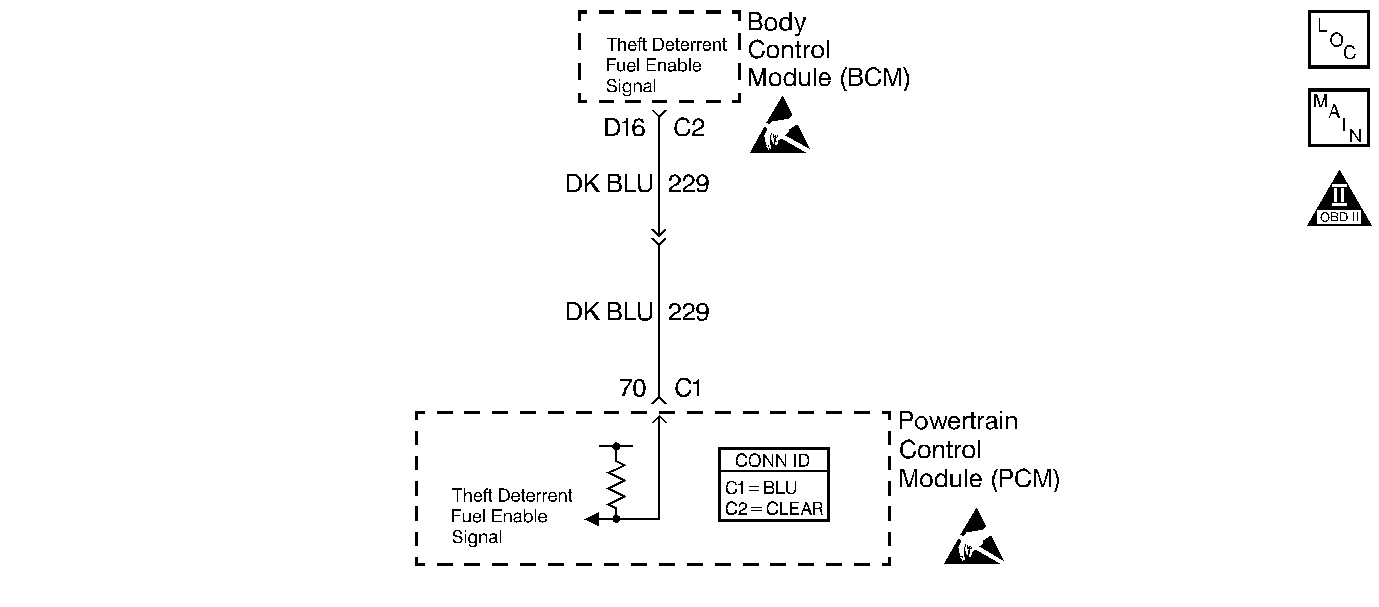
Circuit Description
The Vehicle Content Theft Deterrent System is incorporated within the Body Control Module (BCM). The BCM produces the Theft Deterrent Fuel Enable Signal based on input from the door lock cylinders, shock sensor, and rear compartment lock cylinder. The PCM monitors the Fuel Enable Signal during crank. If the proper signal is present on the Theft Deterrent Fuel Enable Circuit, the PCM enables fuel delivery to allow the engine to start. If the PCM detects that the fuel enable signal is not present or incorrect while an attempt is made to start the engine, DTC P1629 will set. A problem that affects inputs to the BCM will also result in a missing or incorrect fuel enable signal to the PCM. The engine will not start as long as either condition is present. For further information on the Content Theft Deterrent System, refer to Content Theft Deterrent (CTD) System Check .
Conditions for Running the DTC
| • | DTC P1626 is not present. |
| • | An attempt is made to start the engine. |
Conditions for Setting the DTC
| • | The PCM detects an incorrect signal on the Theft Deterrent Fuel Enable Circuit. |
| • | The above conditions are present for longer than 2 seconds. |
Action Taken When the DTC Sets
| • | The PCM will not illuminate the Malfunction Indicator Lamp (MIL). |
| • | The PCM will store conditions which were present when the DTC set as Fail Records data only. This information will not be stored as Freeze Frame data. |
Conditions for Clearing the MIL/DTC
| • | A history DTC will clear after 40 consecutive warm-up cycles have occurred without a malfunction. |
| • | DTC can be cleared by using the scan tool Clear Info function or by disconnecting the PCM battery feed. |
Diagnostic Aids
An intermittent may be caused by a poor connection, rubbed through wire insulation or a wire broken inside the insulation. Check for the following conditions:
| • | Poor connection. Inspect the PCM and BCM harness and connectors for improper mating, broken locks, improperly formed or damaged terminals, and poor terminal to wire connection. |
| • | Damaged harness. Inspect the wiring harness for damage. If the harness appears to be OK, disconnect the BCM, turn the ignition ON and observe a digital multimeter connected to the theft deterrent fuel enable circuit at the BCM harness connector while moving connectors and wiring harnesses related to the vehicle theft deterrent system. A change in voltage will indicate the location of the malfunction. |
Reviewing the Fail Records vehicle mileage since the diagnostic test last failed may help determine how often the condition that caused the DTC to be set occurs. This may assist in diagnosing the condition.
Test Description
Number(s) below refer to the step number(s) on the Diagnostic Table.
Step | Action | Value(s) | Yes | No |
|---|---|---|---|---|
1 | Was the Powertrain On-Board Diagnostic (OBD) System Check performed? | -- | ||
2 |
Important:: Before continuing diagnosis, ensure that the vehicle battery is fully charged. Attempt to start the engine. Does the engine crank? | -- | Go to Content Theft Deterrent (CTD) System Check in Theft Deterrent | |
3 |
Does voltage measure near the specified value? | 5 V | ||
4 |
Is the frequency between the specified values? | 40-60 Hz | ||
5 |
Does the vehicle start and continue running? | -- | Go to Diagnostic Aids | |
6 |
Was a problem found? | -- | ||
7 |
Was a problem found? | -- | ||
8 |
Was a problem found? | -- | Go to Content Theft Deterrent (CTD) System Check in Theft Deterrent | |
|
Important:: The replacement PCM must be programmed. Replace the PCM. Refer to Powertrain Control Module Replacement/Programming . Is action complete? | -- | -- | ||
10 |
Does VTD Fuel Disable display Active? | -- | System OK |
